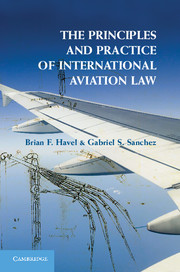Book contents
- Frontmatter
- Contents
- Preface
- Acknowledgments
- Table of Abbreviations and Acronyms
- 1 What is International Aviation Law?
- 2 The Foundations of Public International Aviation Law
- 3 The International Law Regime for Trade in Air Services
- 4 The International Law Regime for Airline Investment and Global Alliances
- 5 The International Law Regime for Aviation Safety and Security
- 6 The International Law Regime for Aviation and the Environment
- 7 The International Law Regime for Air Carrier Liability and Surface Damage
- 8 The International Law Regime for Aircraft Financing and Aircraft Nationality
- Afterword
- Select Bibliography
- Table of Authorities
- Index
- References
8 - The International Law Regime for Aircraft Financing and Aircraft Nationality
Published online by Cambridge University Press: 05 June 2014
- Frontmatter
- Contents
- Preface
- Acknowledgments
- Table of Abbreviations and Acronyms
- 1 What is International Aviation Law?
- 2 The Foundations of Public International Aviation Law
- 3 The International Law Regime for Trade in Air Services
- 4 The International Law Regime for Airline Investment and Global Alliances
- 5 The International Law Regime for Aviation Safety and Security
- 6 The International Law Regime for Aviation and the Environment
- 7 The International Law Regime for Air Carrier Liability and Surface Damage
- 8 The International Law Regime for Aircraft Financing and Aircraft Nationality
- Afterword
- Select Bibliography
- Table of Authorities
- Index
- References
Summary
Distinction Between Equity and Debt
Chapter 4 on investment and alliances considered the airline business model from the perspective of equity: how airlines attract and hold risk capital in their voting stock. Equity, however, is not typically a secured or preferred investment as against an airline’s creditors. It is junior to the debt that an airline takes on from banks, financiers, and other investors. This chapter moves to the debt side of the business equation, examining the principles of public international law and private transnational law that affect how airlines typically pay for their most glamorous but also their most expensive capital asset, the large commercial passenger or cargo aircraft. Today, asset-based financing, where a financier lends money based on the security of the aircraft as collateral, and lease-based aircraft financing constitute international businesses: transactions are inherently complex and cross national boundaries and legal systems.
Private Aircraft Financing and International Aviation Law
In this chapter, therefore, we explore what international aviation law has to say about these quintessentially private law issues of ownership of and security interests in aircraft. Certainly, the private rights of contracting parties, but especially of contracting parties who are negotiating across borders, have long been of concern to the policymakers who develop international aviation law. Nevertheless, the treaties on which we have focused in the preceding chapters have little if anything to say on that subject. The Chicago Convention is a public law instrument that primarily promotes safe and orderly flight operations, liability treaties like the Warsaw and Montreal conventions are concerned with the rights of third parties (passengers and shippers), and bilateral air services treaties give no formal legal standing to the airlines that derive traffic and other rights from them. Recent treaty making has corrected some of the deficit in coverage, but there is still no comprehensive system of transnational substantive property law that governs the full spectrum of purchasing and financing of aircraft. On the other hand, several important rules and principles have emerged in international treaties that shape how aircraft investments are facilitated, and particularly how secured investments are accorded priority, and also how States meet their responsibility to ensure the constant presence of a State of registration to monitor safety compliance by aircraft operators. Those are the rules and principles that we will examine in this chapter.
- Type
- Chapter
- Information
- The Principles and Practice of International Aviation Law , pp. 325 - 392Publisher: Cambridge University PressPrint publication year: 2014



